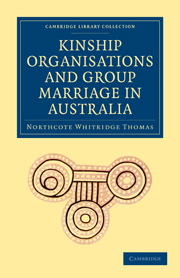Book contents
- Frontmatter
- PREFACE
- Contents
- BIBLIOGRAPHY
- INDEX TO ABBREVIATIONS
- CHAPTER I INTRODUCTORY
- CHAPTER II DESCENT
- CHAPTER III DEFINITIONS AND HISTORY
- CHAPTER IV TABLES OF CLASSES, PHRATRIES, ETC.
- CHAPTER V PHRATRY NAMES
- CHAPTER VI ORIGIN OF PHRATRIES
- CHAPTER VII CLASS NAMES
- CHAPTER VIII THEORIES OF THE ORIGIN OF CLASSES
- CHAPTER IX KINSHIP TERMS
- CHAPTER X TYPES OF SEXUAL UNIONS
- CHAPTER XI GROUP MARRIAGE AND MORGAN'S THEORIES
- CHAPTER XII GROUP MARRIAGE AND THE TERMS OF RELATIONSHIP
- CHAPTER XIII PIRRAURU
- CHAPTER XIV TEMPORARY UNIONS
- APPENDIX: ANOMALOUS MARRIAGES
- INDEX OF PHRATRY, BLOOD, AND CLASS NAMES
- INDEX OF SUBJECTS
- Plate section
CHAPTER V - PHRATRY NAMES
Published online by Cambridge University Press: 05 February 2012
- Frontmatter
- PREFACE
- Contents
- BIBLIOGRAPHY
- INDEX TO ABBREVIATIONS
- CHAPTER I INTRODUCTORY
- CHAPTER II DESCENT
- CHAPTER III DEFINITIONS AND HISTORY
- CHAPTER IV TABLES OF CLASSES, PHRATRIES, ETC.
- CHAPTER V PHRATRY NAMES
- CHAPTER VI ORIGIN OF PHRATRIES
- CHAPTER VII CLASS NAMES
- CHAPTER VIII THEORIES OF THE ORIGIN OF CLASSES
- CHAPTER IX KINSHIP TERMS
- CHAPTER X TYPES OF SEXUAL UNIONS
- CHAPTER XI GROUP MARRIAGE AND MORGAN'S THEORIES
- CHAPTER XII GROUP MARRIAGE AND THE TERMS OF RELATIONSHIP
- CHAPTER XIII PIRRAURU
- CHAPTER XIV TEMPORARY UNIONS
- APPENDIX: ANOMALOUS MARRIAGES
- INDEX OF PHRATRY, BLOOD, AND CLASS NAMES
- INDEX OF SUBJECTS
- Plate section
Summary
It has been shown in Chapter III that from the point of view of kinship organisations Australia falls into three main areas—occupied by the classless two-phratry, the four-class and the eight-class organisations. The total number of phratry names, thirty-three pairs in all, does not of course fall solely to the count of the two-phratry tribes, but is divided between the three kinds of organisation, the two-phratry having twelve pairs with one anomalous area, the four-class sixteen, and the eight-class five such sets. As regards the relative size of the areas thus organised, the largest seems to be that occupied by the Matteri-Kiraru system, though the Muquara-Kilpara (5) probably runs it close, especially if we take into account the names of like meaning (1–4) in the East Victorian area. The remainder of the two-phratry systems do not range over a wide extent of country, so far as is known; but 10, 11, and 33 are of unknown extent.
In the four-class area are two extensive systems, ranking next after those of South Australia and N.S. Wales; these are Mallera-Wuthera (27) and Pakoota-Wootaro (29); they have a single phratry name in common, which is also found in two other systems; if we add these together, as we may perhaps do on this evidence of a common basis, we have by far the largest phratric system in Australia as the result.
- Type
- Chapter
- Information
- Kinship Organisations and Group Marriage in Australia , pp. 52 - 62Publisher: Cambridge University PressPrint publication year: 2010First published in: 1906



